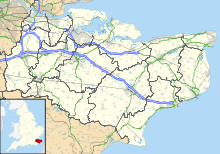Bekesbourne Aerodrome
| Bekesbourne Aerodrome | |
|---|---|
 |
|
| Summary | |
| Airport type | Private |
| Serves | Canterbury |
| Location | 6 km (3.7 mi) southeast of Canterbury |
| Elevation AMSL | 170 ft / 52 m |
| Coordinates | 51°15′16″N 1°9′22″E / 51.25444°N 1.15611°ECoordinates: 51°15′16″N 1°9′22″E / 51.25444°N 1.15611°E |
| Map | |
| Location in England | |
Bekesbourne Aerodrome was an airport located at the southeast edge of the village of Bekesbourne, southwest of Canterbury, Kent. It operated from 1916 until 1940, and had both military and civil roles.
The airfield started as RFC Bekesbourne when the Royal Flying Corps requisitioned 98 acres (40 ha) of land in 1916 as an Emergency Landing Ground (ELG). B flight of No. 50 (Home Defence) Squadron moved in, operating Armstrong Whitworth F.K.3 and F.K.8 and Royal Aircraft Factory B.E.2 and B.E.12 aircraft. Very little action was seen. After a German bombing raid on London in 1917, some S.E.5 aircraft from No.56 Squadron were brought in between June 21st and July 5th, but again, no combat operations were undertaken.
Despite the land being on a slope, and quite restricted in dimensions (there is a railway line on the northern boundary), 50 Squadron moved in entirely on the 8th February 1918, and soon standardised on the S.E.5A fighter. With the creation of the Royal Air Force on 1st April, the Squadron's duties expanded at what was now RAF Bekesbourne, and it upgraded its tents and temporary buildings. The S.E.5A aircraft were found to take too long to warm up, and during August were replaced by 24 Sopwith Camels.
By September 1918 two Belfast Truss hangars hade been completed, along with other buildings. The squadron nicknamed its hangar "The Nest". The Commanding Officer from December 1918 until disbandment was Major A T Harris AFC., Later Marshal of the Royal Air Force Sir Arthur Harris GCB OBE AFC. 50 Squadron was disbanded in June 1919.
...
Wikipedia


